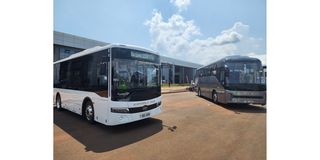Collaborative opportunities for Tanzania as Uganda unveils e-mobility plan

What you need to know:
- Uganda is encouraging Tanzanian investors to consider setting up electric vehicle manufacturing operations within Uganda
Jinja. As Uganda positions itself as a leader in East Africa’s e-mobility sector, it is extending an invitation to Tanzania for collaborative ventures that could benefit both nations.
The areas for collaboration and partnerships as identified by the government of Uganda focus on investment, market sharing and technological collaboration in the electric vehicle (EV) ecosystem.
This is according to Uganda’s Minister for Science, Technology and Innovation, Ms Monica Msanza, who spoke during the Uganda e-mobility expo here in Jinja at the weekend.
The expo showcased Uganda’s strides in electric vehicle manufacturing, with a new plant set to officially launch by the end of this year through Kiira Motors Corporation (KMC).
Currently, KMC operates a smaller facility in Kampala, where it has produced over 40 electric buses now in service across major Ugandan cities such as Kampala, Entebbe and Jinja.
The new plant, designed to produce up to 250 electric vehicles per month, will have an annual capacity of 5,000 vehicles, contributing zero carbon emissions.
The Ugandan government envisions this plant as a regional asset, with hopes that neighbouring countries like Tanzania will join in leveraging its potential.
One primary area of interest is investment.
Uganda is encouraging Tanzanian investors to consider setting up electric vehicle manufacturing operations within Uganda.
This move aims to foster regional integration and technological advancement.
Another significant area of collaboration involves market sharing. Tanzania’s need for accessible public transport aligns with Uganda’s ongoing negotiations to provide electric buses.
The potential for Tanzanian cities to integrate these buses into their transport systems represents a major step forward in sustainable urban mobility.
Ms Msanza emphasised the potential benefits of shared expertise.
She noted that Tanzanian universities and innovators could play a crucial role in manufacturing components for electric buses.
This local collaboration could reduce reliance on imports and bolster regional supply chains.
“The mobility industry, valued at $15 trillion in 2017, is expected to exceed $26.6 trillion by 2030,” Ms Msanza explained.
“As the vehicle market in sub-Saharan Africa grows, with an anticipated rise from 2.7 million vehicles in 2021 to 58 million by 2040, transitioning to e-mobility is crucial for reducing greenhouse gas emissions.”
While acknowledging the challenges of shifting from traditional combustion engines to electric alternatives, Ms Msanza is optimistic about the long-term benefits of e-mobility.
“Understanding will grow over time as the advantages of reduced carbon emissions become more apparent,” she said.
A business anthropologist and consultant from Uganda, Dr Shamim Matovu, underscored the importance of knowledge management and quality standards in achieving competitive regional markets.
She stressed that learning from other African nations already exporting to Europe and investing in local research are critical for success.
“This e-mobility conversation should be inclusive,” Dr Matovu added.
“Knowledge about tackling climate change and the benefits of e-mobility should be accessible to everyone, not just the educated few.”
The national secretary of the Tanzania Bus Owners Association (Taboa), Mr Joseph Priscus, recognized the significant benefits Tanzania could gain from the e-mobility project.
He said e-mobility reduces fuel costs, a crucial factor given fluctuating fuel prices.
He praised Uganda’s efforts and expressed confidence that other countries in the region will also benefit from the expanded value chain.
This comes at a time when various international organisations, including the United Nations Environment Programme (UNEP), were working on several initiatives to boost a switch from internal combustion engines to those powered by electricity to achieve net-zero emissions targets.
The Head of the Sustainable Mobility Unit at UNEP, Rob De Jong, is on record as having said the transitioning from vehicles with internal combustion engines to those powered by electricity was not just a trend but rather a necessary shift to achieve net-zero emissions targets.
In Tanzania, UNEP is working to spearhead the shift to electric vehicles through its Global Electric Mobility Programme.
Along with countering climate change, the transition could create new economic opportunities, found a recent UNEP-led report.
Tanzania has about 1.2 million motorcycles and three-wheelers with internal combustion engines.
At least 10 companies have entered the country’s electric mobility market, hoping to capitalise on an untapped opportunity.
It is estimated that Tanzania has the highest number of electric vehicles (EVs) in East Africa, totalling around 5000 vehicles cruising its streets.




